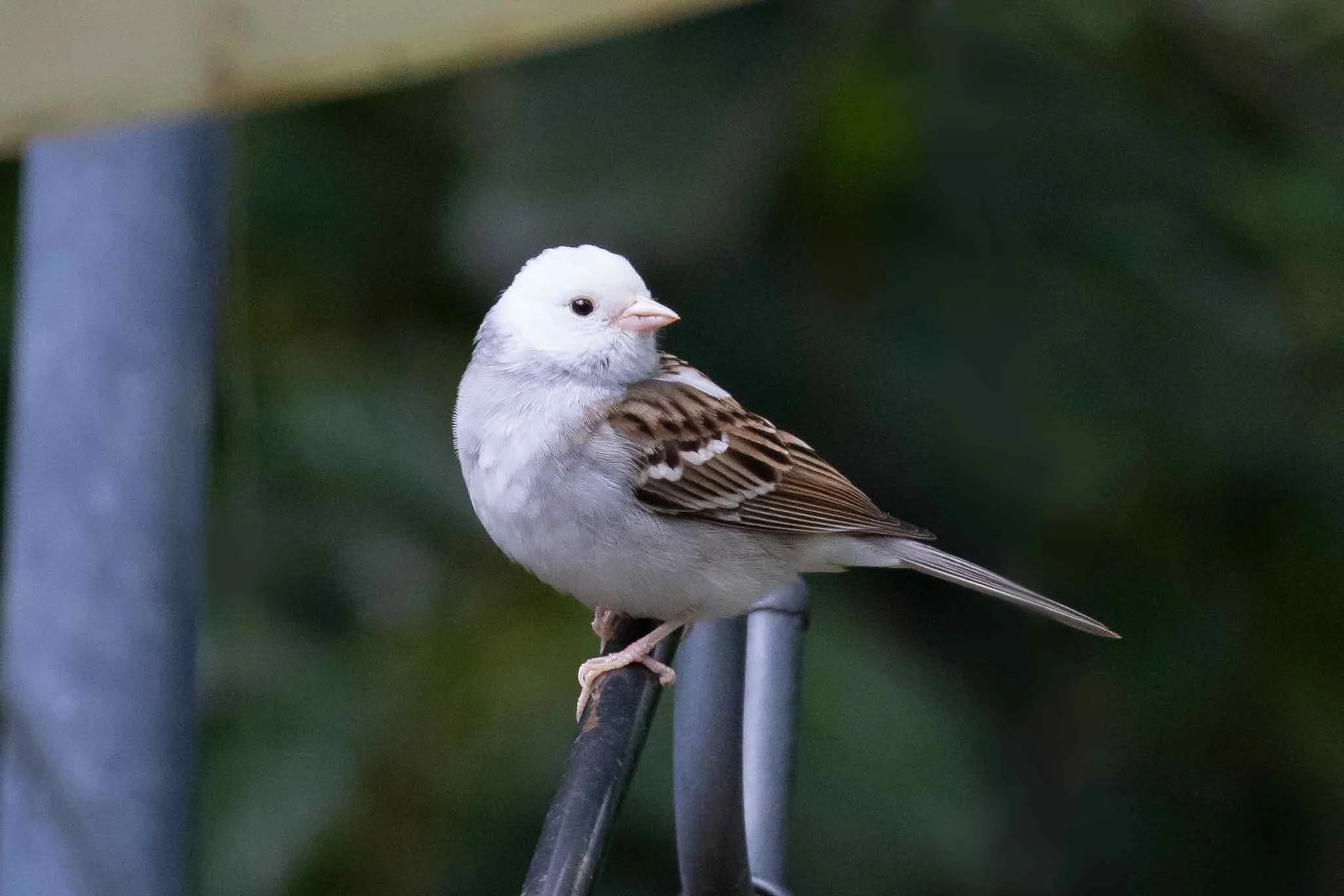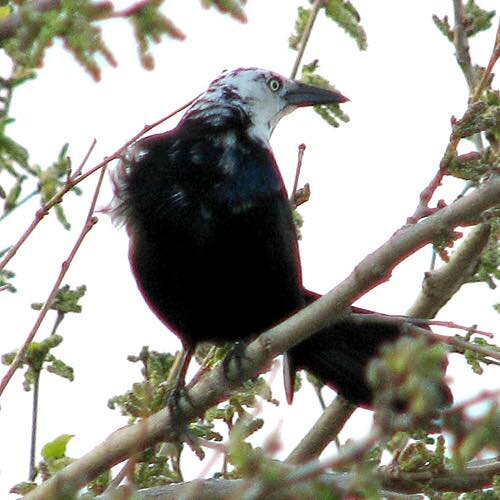Photo: Chipping Sparrow, Ashley Bradford
William Young
In late April, Ashley Bradford photographed a Chipping Sparrow with a totally white head. The name for the condition which caused this color abnormality is disputed. Some call it leucism. Others call it partial albinism.
Chipping Sparrow, Ashley Bradford
The word leucism (pronounced loos-ism) is derived from the Greek leukos, which means white or clear. The default color for bird feathers is white. Black and brown coloration is produced by the pigment melanin, a word that comes from the Greek melas, which means black. An enzyme produces this pigment. If a bird cannot produce melanin or if the melanin produced cannot properly reach the feathers, a color abnormality can result, causing some or all of the feathers to be white or a lighter color than normal. If the feathers have a washed-out appearance, the bird is said to have dilute plumage.
Some scientists say that leucistic birds have no melanin in some or all of their feathers. In the photographs below, a Malachite Kingfisher I saw in Uganda conforms with this definition, because it did not appear to have any melanin in its feathers.
Leucistic Malachite Kingfisher, William Young
Typical Malachite Kingfisher, William Young
A bird with white splotches on its feathers would not be considered leucistic. The male American Robin pictured below would be in a category that David Sibley and others would call a partial albino. (See Sibley's article "Abnormal coloration in birds: Melanin reduction" here.
Partial Albino American Robin, William Young
Leucistic birds and pure albino birds differ in a few ways. Pure albino birds are always totally white. They have a genetic condition that causes a lack of the enzyme tyrosinase, and they are unable to produce melanin. Their eyes and soft parts (bill, skin, legs, etc.) appear reddish-pink, because blood vessels show through their colorless skin. Leucistic birds can produce melanin, but it does not get into some or all of their feathers. Their affected feathers can be either all white or appear washed out, but their eyes and soft parts are the normal color. When leucistic birds molt, their new plumage can look different than it did before the molt, showing either a greater or lesser number of white or washed-out feathers.
To add to the confusion, a condition called fright molt can result in a bird having some feathers that are temporarily white. An example would be if a bird loses some feathers to a predator. Temporary feathers might grow back without pigment and be white. The next time the bird molts, the new feathers will contain pigment.
The word bald in Bald Eagle means white rather than featherless. The head of Ashley's Chipping Sparrow would fit this definition. The head of the grackle pictured below is mostly bald.
Common Grackle, Ashley Bradford
In 2019, a White-throated Sparrow with a mostly white head showed up at Monticello Park in Alexandria. The bird still had the yellow patch near its eye, and there were portions of the black crown stripes on its head.
White-throated Sparrow, William Young
In 2014, a white-headed Tree Swallow was at Riley's Lock along the C&O Canal Towpath in Maryland.
Tree Swallow, Ashley Bradford
Lola Oberman wrote an article for the Audubon Naturalist Society News about birds with color abnormalities. She related a story about a pale beige Tree Swallow flying among a large group of Tree swallows with typical coloration. She said numerous "normal" Tree Swallows attacked the beige one and forced it into the water. The beige swallow managed to fly out of the water, but Oberman thought the bird was probably doomed, because it would be the subject of similar attacks.
Whether a bird with abnormal plumage will be accepted by members of its species depends on the species and the circumstances. Ashley's Chipping Sparrow was not harassed by other Chipping Sparrows in her yard. I have seen a single white-phase Snow Goose feeding in a large group of Canada Geese with no apparent conflict. I am not aware of any studies that have been done about the ability of abnormally colored wild birds to find mates and reproduce. However, a male cardinal with an unfeathered head was at Monticello Park for a few years, and he was often accompanied by a female.
Some abnormally colored birds can appear to be more attractive than others of their species in normal plumage. If a bird with abnormal plumage visits an area over a prolonged period, it can provide an opportunity to study the behavior of an individual bird, because you can easily differentiate it from others of its species.
Chipping Sparrows, Ashley Bradford
Such birds can help birders to sharpen their identification skills. Most birders identify Chipping Sparrows by looking at the head. When the head is all white, you have to identify it by looking at the rest of the bird, including bill shape and color, pattern on the back, etc. Identifying one of these abnormal birds can provide a similar type of satisfaction to identifying a rare species.
William Young is the author of the book The Fascination of Birds: From the Albatross to the Yellowthroat. He and Ashley Bradford created the MPNature.com website.









